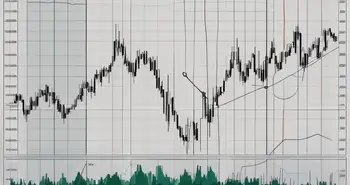Oil Price Forecast: What to Expect in the Coming Months

As an expert in the field of oil pricing, I am here to provide you with a comprehensive forecast of what to expect in the coming months. The oil market is a complex and ever-changing landscape, influenced by various factors that drive prices up or down. By understanding the basics of oil pricing, predicting trends, and analyzing potential scenarios, we can gain valuable insight into the future of oil prices and its impact on the global economy.
Understanding the Basics of Oil Pricing
To comprehend oil pricing, we must first recognize the crucial role that supply and demand play in this market. When supply surpasses demand, prices tend to decrease, and vice versa. However, this simple relationship is often affected by numerous geopolitical factors and economic indicators.
The Role of Supply and Demand in Oil Pricing
Supply and demand dynamics directly impact oil prices. In recent years, we have witnessed significant fluctuations due to changes in production levels, both from traditional oil-producing countries and emerging players. Oftentimes, geopolitical tensions and conflicts can disrupt oil supplies, leading to price increases. On the demand side, economic growth and industrial activities heavily influence the need for oil. In particular, developing countries with expanding economies tend to exhibit a rising demand for energy resources.
For example, the rapid industrialization of countries like China and India has contributed to a surge in oil demand. As these nations continue to experience economic growth, their energy requirements are expected to increase further. This growing demand places additional pressure on oil prices, as suppliers struggle to meet the needs of these expanding economies.
Moreover, supply disruptions caused by natural disasters or political instability can have a significant impact on oil pricing. Hurricanes, such as Hurricane Katrina in 2005, have disrupted oil production and refining facilities, leading to a temporary spike in prices. Similarly, political conflicts in oil-rich regions, like the ongoing tensions in the South China Sea, can create uncertainties in the market, causing prices to fluctuate.
Impact of Geopolitical Factors on Oil Prices
The global oil market is inherently sensitive to geopolitical factors. Political events such as conflicts, sanctions, and political unrest in major oil-producing countries can cause supply disruption, leading to price spikes. For instance, tensions in the Middle East have historically had a substantial impact on oil prices. As an expert in oil pricing, I have witnessed how geopolitical instability can create an uncertain environment for oil investors and consumers alike.
Furthermore, geopolitical factors can also influence the investment decisions of oil companies. The fear of supply disruptions or political instability in certain regions may lead companies to invest in alternative energy sources or diversify their oil supply chains. These strategic decisions can have long-term implications for the oil market, affecting both supply and demand dynamics.
Influence of Economic Indicators on Oil Pricing
Economic indicators serve as vital benchmarks for understanding oil pricing trends. Factors such as GDP growth, inflation rates, and trade balances can provide valuable insights into future oil demand and price levels. For instance, during periods of robust economic growth, oil prices generally rise due to increased energy consumption by businesses and consumers. Conversely, economic slowdowns can result in reduced oil demand and lower prices.
Additionally, changes in currency exchange rates can also impact oil pricing. Fluctuations in the value of major currencies, such as the US dollar, can affect the purchasing power of oil-importing countries. A stronger dollar can make oil more expensive for these countries, potentially reducing their demand and putting downward pressure on prices.
Moreover, technological advancements and shifts towards renewable energy sources can influence oil pricing. The development of more efficient technologies and the increasing adoption of renewable energy alternatives can potentially reduce global oil demand, leading to lower prices. As governments and industries worldwide strive to transition to cleaner and more sustainable energy systems, the future of oil pricing remains uncertain.
Predicting Oil Price Trends
Forecasting oil price trends requires a deep analysis of various key factors that shape the market. By considering factors such as supply and demand, the role of OPEC, and technological advancements, we can form an informed view of where prices might be headed in the future.
Key Factors Influencing Future Oil Prices
Several key factors will play a significant role in determining future oil prices. These include global economic growth prospects, advancements in renewable energy technologies, geopolitical events, and government policies. As a seasoned expert in oil pricing, I closely monitor these factors to assess their potential impact on the market.
The Role of OPEC in Oil Price Forecasting
OPEC, the Organization of Petroleum Exporting Countries, plays a vital role in the oil market. As a collective organization consisting of major oil-producing nations, OPEC has the power to influence prices by adjusting production levels. Decisions made during OPEC meetings can have a significant impact on the market sentiment and oil prices as a whole.
Technological Advancements and Their Impact on Oil Prices
Technological advancements in the energy sector, such as the development of renewable energy sources and improvements in oil extraction techniques, can impact oil prices. Increased efficiency in oil production can lead to higher supply levels, potentially putting downward pressure on prices. Furthermore, shifts towards renewable and sustainable energy alternatives may reduce dependence on oil, contributing to long-term price stabilization.
Potential Scenarios for Oil Prices in the Coming Months
As an expert in oil price forecasting, I am constantly evaluating potential scenarios that could unfold in the coming months. While the future remains uncertain, we can assess the best-case, worst-case, and most likely scenarios based on current market conditions.
Best-Case Scenario for Oil Prices
In the best-case scenario, we would witness a balance between supply and demand, resulting in stable oil prices. Collaboration among major oil-producing countries and a favorable global economic environment would contribute to a steady and reasonable oil price range. Consumers and businesses would benefit from predictability and moderate energy costs, supporting economic growth and development.
Worst-Case Scenario for Oil Prices
The worst-case scenario for oil prices would involve a combination of factors leading to extreme volatility and price spikes. Geopolitical tensions escalating into conflict, disruptions in major oil-producing regions, and a global economic downturn could contribute to a sharp increase in prices. This would pose challenges for consumers, particularly those heavily reliant on oil imports, and could negatively impact economic stability.
Most Likely Scenario for Oil Prices
Based on careful analysis, the most likely scenario for oil prices in the coming months suggests a cautiously optimistic outlook. Barring any unexpected major supply disruptions or geopolitical events, we anticipate a gradual recovery in global energy demand as economies continue to rebound. This, coupled with ongoing efforts to stabilize oil production among major oil producers, should result in a modest increase in prices, providing a stable environment for businesses and consumers alike.
How Oil Price Fluctuations Impact the Global Economy
It is essential to understand how oil price fluctuations can reverberate throughout the global economy. From consumer spending and inflation to the energy sector and national economies, the impact is far-reaching and consequential.
Effects on Consumer Spending and Inflation
Oil price fluctuations can directly affect consumer spending patterns and overall inflation rates. When oil prices rise, transportation costs increase, leading to higher prices for goods and services. This can reduce consumers' purchasing power and potentially influence inflation. On the other hand, falling oil prices can provide a temporary boost to consumer spending, as fuel costs decrease and disposable income rises.
Impact on Energy Sector and Related Industries
The energy sector and related industries, such as petrochemicals and transportation, are directly impacted by oil price fluctuations. Higher prices can lead to increased profitability for oil companies, incentivizing investment in exploration and production. Conversely, lower prices can create challenges for oil producers, leading to reduced investments and potential job losses. Additionally, renewable energy sectors may face increased competition during periods of low oil prices.
Implications for National Economies and Global Trade
Oil price fluctuations have profound implications for national economies and global trade patterns. Oil-exporting countries heavily rely on oil revenues to fund government initiatives and drive economic growth. Therefore, lower oil prices can severely impact their budgets and economic stability. Conversely, oil-importing countries benefit from reduced energy costs, which can stimulate economic activity and increase their international competitiveness in trade.
As an oil price forecasting expert, I have witnessed the immense impact that oil prices can have on the global economy. It is imperative for businesses, policymakers, and consumers alike to stay informed and prepared for potential shifts, enabling them to adapt and thrive in an ever-changing oil market.
FAQ
What are the key factors influencing oil prices?
The key factors influencing oil prices include supply and demand dynamics, geopolitical events, and economic indicators such as GDP growth and inflation rates.
How does OPEC influence oil prices?
OPEC influences oil prices through its collective decision-making on production levels. By adjusting output, OPEC can influence the global supply of oil, which can impact prices in the market.
What role do technological advancements play in oil pricing?
Technological advancements in the energy sector can impact oil prices by improving extraction techniques and increasing overall production efficiency.
What is the most likely scenario for oil prices in the coming months?
The most likely scenario for oil prices involves a modest increase as global energy demand gradually recovers and efforts to stabilize production continue.
How do oil price fluctuations impact the global economy?
Oil price fluctuations impact the global economy through effects on consumer spending, inflation, the energy sector, and national economies with both positive and negative implications.
As you navigate the complexities of oil price forecasts and their impact on the global economy, empower your trading strategy with Morpher. Our innovative platform, built on blockchain technology, offers you the flexibility to trade oil alongside a diverse range of asset classes, including stocks, cryptocurrencies, forex, and more, all with zero fees and infinite liquidity. Whether you're looking to invest fractionally, short sell without interest fees, or leverage your trades up to 10x, Morpher provides the tools for a unique and advanced trading experience. Take control of your investments with the safety and autonomy of the Morpher Wallet. Ready to transform your trading journey? Sign Up and Get Your Free Sign Up Bonus today and join the future of investing with Morpher.

Disclaimer: All investments involve risk, and the past performance of a security, industry, sector, market, financial product, trading strategy, or individual’s trading does not guarantee future results or returns. Investors are fully responsible for any investment decisions they make. Such decisions should be based solely on an evaluation of their financial circumstances, investment objectives, risk tolerance, and liquidity needs. This post does not constitute investment advice.

Painless trading for everyone
Hundreds of markets all in one place - Apple, Bitcoin, Gold, Watches, NFTs, Sneakers and so much more.

Painless trading for everyone
Hundreds of markets all in one place - Apple, Bitcoin, Gold, Watches, NFTs, Sneakers and so much more.









